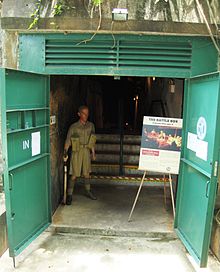The Battle Box
The Battle Box is the name of the former bunker complex under Fort Canning in Singapore . The facility served as the command center of the British Army during the Second World War and is now used as a museum .
history
prehistory
In the course of the Singapore strategy of the British Empire , Singapore was of outstanding importance as a base for British forces. From here the defense of the British possessions against a possible attack by the Japanese Empire should be organized. Above all, the location of Singapore on the Strait of Malacca and the associated control of the transition between the South China Sea and the Bay of Bengal was decisive for the defense of British India .
As part of this strategy, the construction of the Singapore Naval Base began in 1919 . This should serve as a base for the Royal Navy . In addition, Singapore's fortifications have been significantly strengthened. In order to be able to coordinate the joint defense between the Royal Air Force , British Army and Royal Navy, the construction of a new command bunker began under Fort Canning in 1926. This was called The Battle Box .
Construction of the facility
The system was built from 1926 about 10 m below the access building in Fort Canning. The walls consist of one meter thick concrete, which should also offer protection against direct bomb and artillery hits. The total number of rooms in the facility varies, depending on the source, between 22, 26 and 29. The bunker system was equipped with communication systems, bedrooms and social rooms, among other things.
Second World War
During the Second World War it quickly became apparent that the premises were too small for the coordination of all armed forces. The headquarters of the British troops were relocated within Singapore. Only the Commandant of the Singapore Fortress, Major General Frank Keith Simmons, and his staff continue to use the premises within the Battle Box . As the Battle of Singapore progressed , the headquarters of the British forces were moved back to Fort Canning. During a meeting in the communication room of the Battle Box on February 15, 1942 Arthur Percival made the decision to surrender.
The Japanese armed forces also used the premises as a communication base for the defense of Singapore until their own surrender on August 15, 1945.
Use after the Second World War
After the Second World War, the facility was used again by British troops as a base. With the independence of Singapore, Fort Canning passed to the armed forces of Singapore , which set up an officers' school (Goh Keng Swee Command and Staff College) here. The bunker itself was closed for security reasons and was forgotten. It was only rediscovered by a journalist in 1988.
Todays use
On February 15, 1997, the 55th anniversary of Singapore's surrender in World War II, the facility was finally opened to the public as a museum. This tells the story of the last days before the surrender. In 2013 the facility was revised for US $ 300,000 and the exhibition concept revised. The exhibition was reopened on January 28, 2016. Over 60,000 people visit the museum every year.
See also
Web links
Individual evidence
- ^ David McIntyre: "The Rise and Fall of the Singapore Naval Base, 1919-1942" (English), Shoe String Pr Inc, 1980, ISBN 9780208018359
- ↑ History of the system on the museum's website , accessed on November 30, 2016
- ↑ Colin Smith "Singapore Burning: Heroism and Surrender in World War II" (English), Viking, 2005, ISBN 9780670913411
- ↑ Clem McMurray: "The Singapore Battle Box" (English; PDF , 144 KB) at www.fom.sg, accessed on November 30, 2016
- ^ Romen Bose: "Secrets of the Battlebox: The History and Role of Britain's Command HQ in the Malayan Campaign" (English), Marshall Cavendish Editions, 2005, ISBN 9789812610645
- ↑ Melody Zaccheus: "$ 300,000 makeover for WWII bunker Battle Box" , on www.straitstimes.com January 20, 2016, accessed November 30, 2016
- ↑ Nadia Jansen Hassan: "Battle Box bunker officially opens after 2-year revamp" (English), on www.channelnewsasia.com from June 28, 2016, accessed on November 30, 2016
